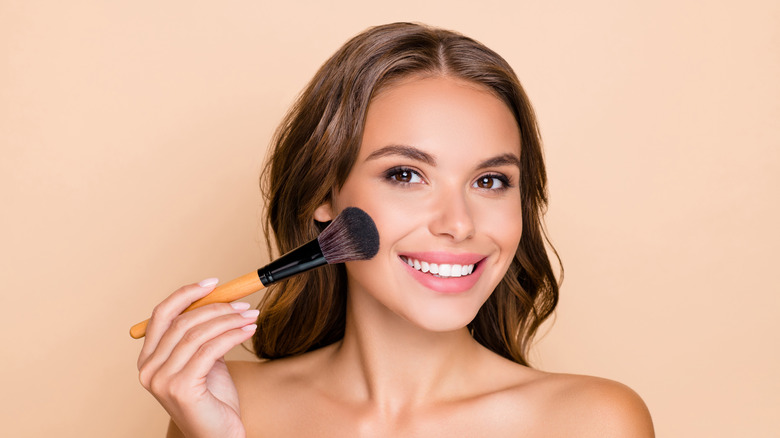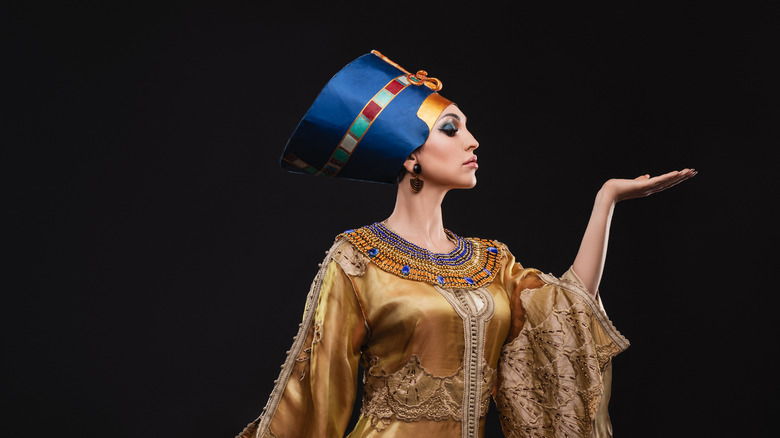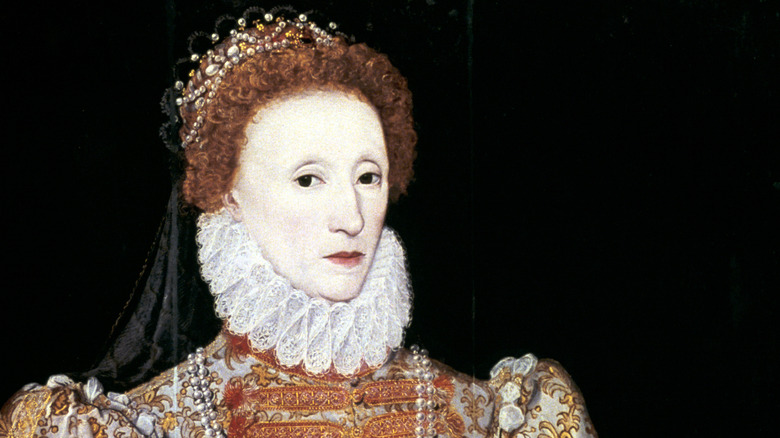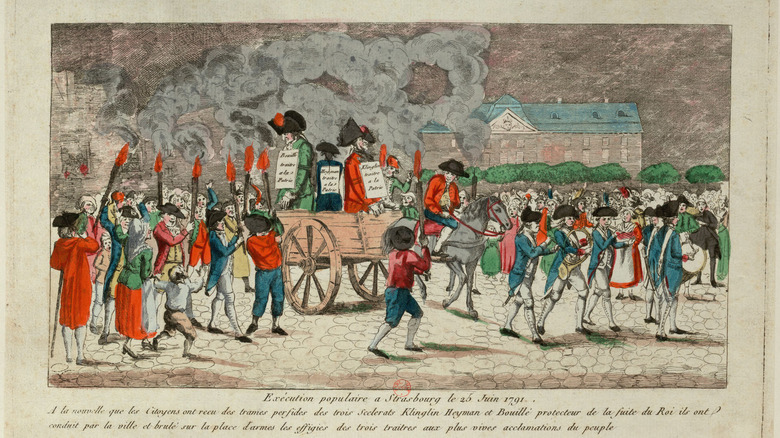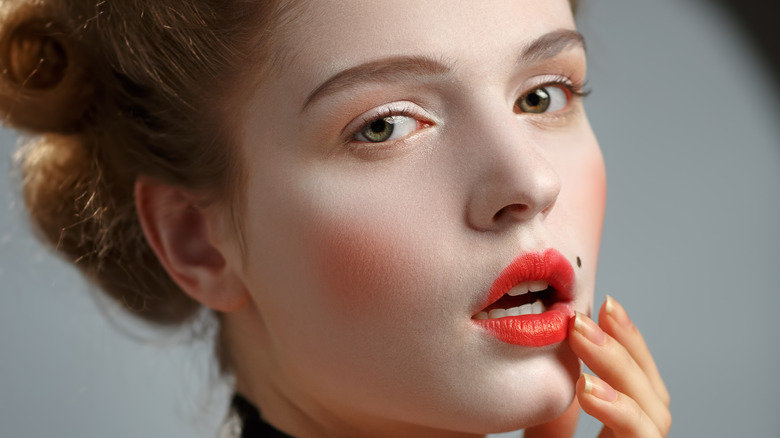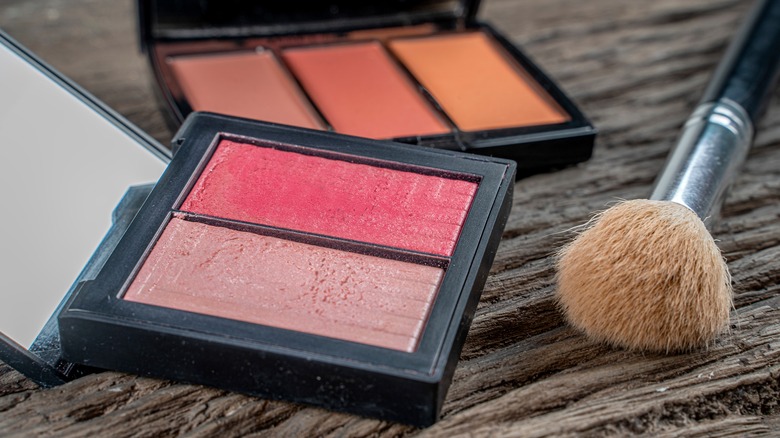Inside The Ancient And Polarizing History Of Blush
Today, if you watch makeup tutorials or read articles about how to apply blush, you'll see multiple trends at once. Everything from cream blush to highlighting blush to good old-fashioned powder blush is made by countless makeup brands. Some makeup mavens insist applying blush to the tip of your nose as well as your cheeks helps to create a natural-looking sun-kissed glow that works for multiple skin tones (via L'Oreal Paris). Some say applying it to the apples of your cheeks is a classic move for a reason, while others caution you never to fall prey to this old practice and instead apply it to your cheekbones only (via The Beauty Department).
Of course this all depends on the shape of your face and the look you are trying to achieve, but it's amusing to us how passionately some experts seem to feel about the right way and wrong way to apply this centuries-old cosmetic staple. But to tell the truth, blush (or "rouge" as it was once more commonly called) has always been a rather polarizing makeup product and has elicited strong feelings from those for and against it throughout its long history.
Where blush originated
The practice of using cosmetics to give a person's cheeks a flush of color began thousands of years ago in ancient Egypt (via Insider). At the time, both men and women used a mix of crushed red ochre mixed with fat to add pinkish/reddish color to both their lips and their cheeks that stood in stark contrast to the dark eye makeup that was also used by both men and women of the time period.
By the time of Roman Empire, blush was relegated mostly to women, who used the pigment from red clay or berries added to a chalky powder made from gypsum (via Town and Country). During China's Tang Dynasty, women made blush out of pomegranate, safflower, and a mineral called cinnabar. While pomegranate and safflower were likely harmless, cinnabar unfortunately contains toxic mercury. This was the first but most certainly not the last time that cosmetic blush would prove toxic to its users.
The first time blush fell out of favor
While several ancient cultures appreciated the lively color that cosmetic blush gave to a person's face, by the time of the middle ages in western cultures, it had fallen quite out of favor. There were a few reasons for this. The first was that very pale skin had become associated with wealth and the ruling class (via Into the Gloss). If you worked in the fields all day, you were likely to get a tan, and if you worked a trade or spent all day milking cows or churning butter, you were likely to have a natural flush to your face from the exercise. The wealthiest people didn't have to work; they stayed indoors and tended to their high society business, therefore remaining paler.
In the Elizabethan period, Queen Elizabeth I of England had a major hand in furthering the popular look of a pale face, as she famously used what we now know to be a super-toxic form of lead-based makeup to appear as white as possible. The spread of illnesses like smallpox during the following centuries left unsightly marks on people's faces, which they covered up with similarly toxic (and white) means.
How a revolution brought blush back
It might sound strange, but a major event in European history had a hand in ending the popularity of a pale face and bringing back the demand for cosmetics that created a flush to the cheeks: The French Revolution (via Into the Gloss). The French Revolution, which lasted from 1789 to 1794, saw the people of France rise up against the ruling class in order to create a more democratic society and more equal opportunity for those not born into immense wealth (via The National Archives of the United Kingdom). This revolution created shock waves throughout Europe and was generally approved of by the newly formed United States of America, as The Revolutionary War was fought on similar principles.
During this time, the wealthy across Europe realized they may need to create a new face for themselves (literally and figuratively) if they wished not to be dragged from their estates by peasants, and so the long-popular pale face of the aristocracy went the way of the Dodo. In 1825, a book called "The Art of Beauty" was published in England, and this guide said that rouge ought to be "rendered extremely innocently," and suggested the use of things like safflower, red sandalwood, Brazil wood, and everyone's favorite beetle-derived ingredient: carmine (via Into The Gloss).
In short, blush was back.
The controversial reasons people did and didn't wear blush
The Victorian Era was quite the time where it came to cosmetics; as we've told you in previous articles, it was a time when women had false eyelashes sewn into their lids and used burnt lamp oil and coal dust as eye liner. The blush of the day has equally fascinating and strange stories surrounding it.
Tuberculosis, known at the time as "Consumption," was a commonplace and terrible illness that before the invention of antibiotics was often a death sentence. That said, for some reason, there was a movement to intentionally re-create the flushed cheeks and face of a TB patient by using blush (via Into the Gloss). At the same time, there was pushback against using blush because this type of cosmetic had become associated with prostitution and women of "loose morals" (via Insider). In fact, Queen Victoria of England herself outright stated that she thought wearing a great deal of cosmetics, especially red lipstick and rouge, was impolite.
The mass production and adoption of blush
By the turn of the 20th century, whether you thought blush was impolite or a necessary staple, it was everywhere. Companies began mass producing it, and so women were able to purchase and use uniform formulations that were, for the most part, safer than their ancient counterparts (via Insider). By the roaring twenties, flappers paired blush with heavy and dark eye makeup. The famous starlets of the fifties like Marilyn Monroe wore it also, and so it was now officially in fashion. The orangey blush of the 80's was a staple for the fashion-forward woman, and the apple-cheeked looks of the 90's could never have happened without rouge.
While blush took a back seat to the contouring trends of the 2010's, Town and Country Magazine says its officially back, and if you follow any beauty bloggers, TikTok accounts, or YouTube makeup artists, you're likely seeing the same thing: blush is on trend.
So whether you're trying to recreate the look of a 1950's movie star or make yourself appear like a hardworking milkmaid, be assured that you're in good company. And if it falls out of fashion, wait: history repeats itself. Blush, we firmly believe, will always be back.
